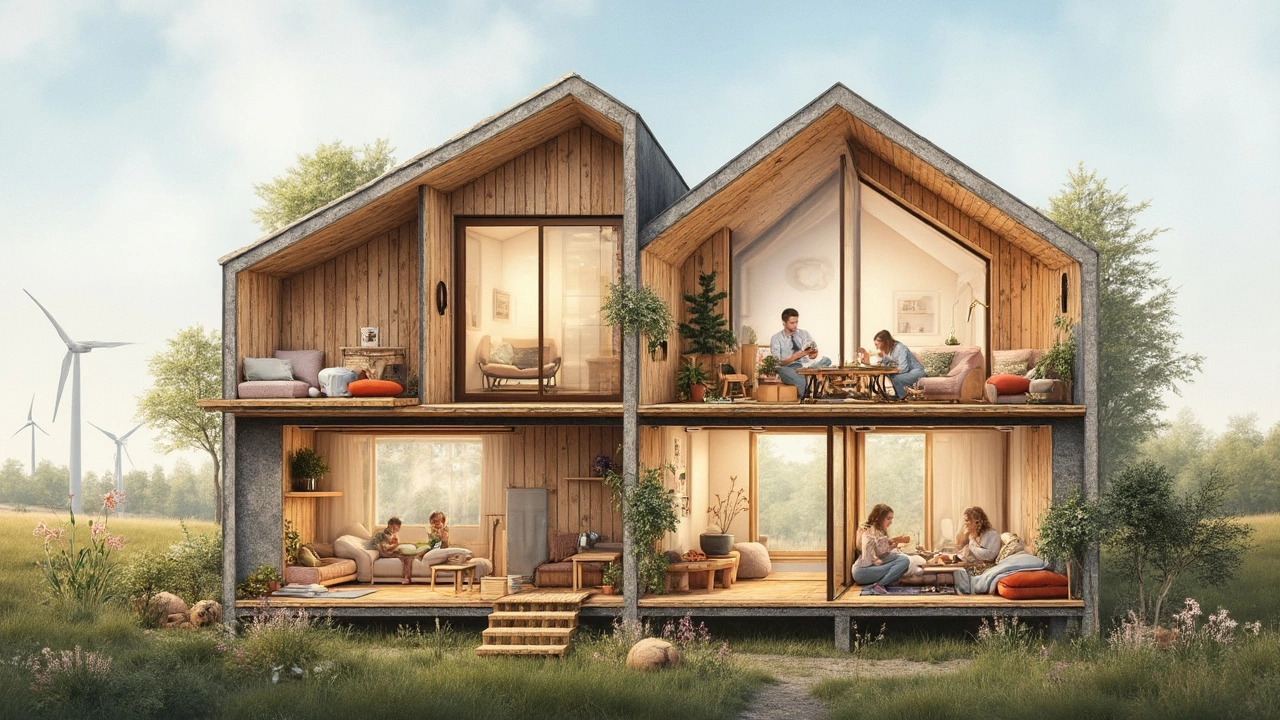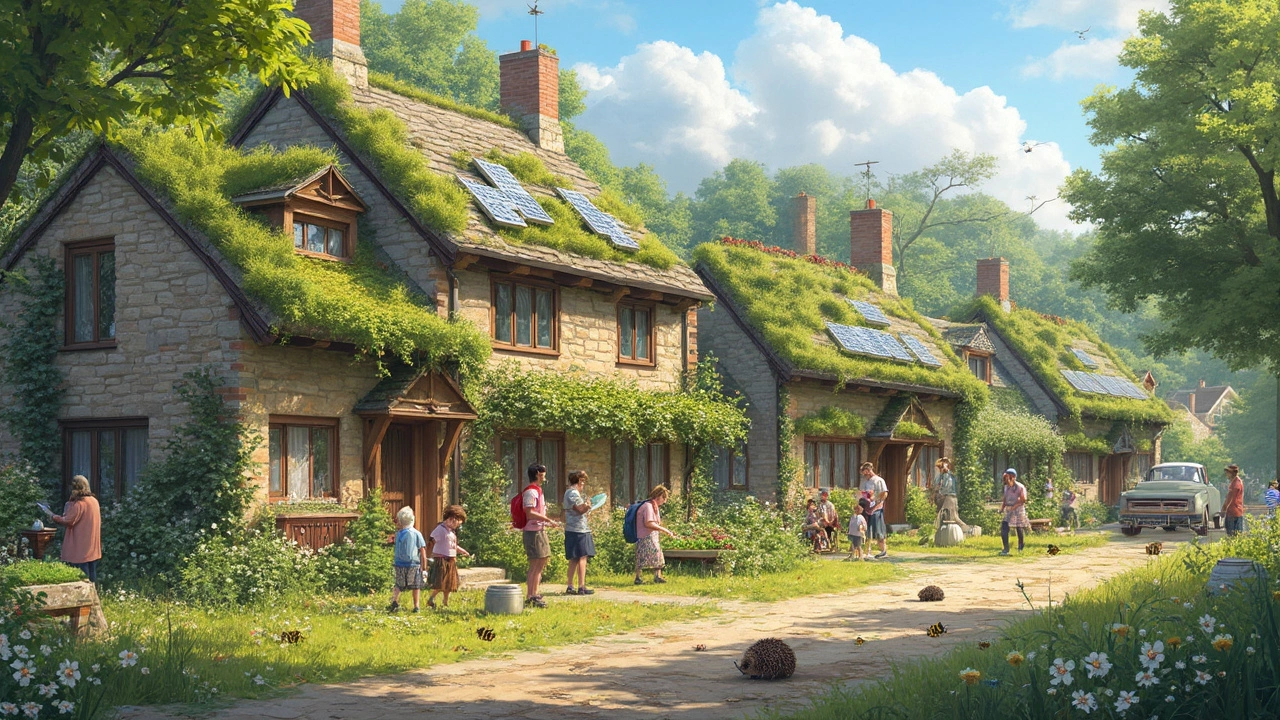Ever hear someone say they live in a ‘green home’ or a ‘net-zero house’ and wonder if that’s just marketing speak? Turns out, there’s more than one way to name an eco-friendly house, and not all of them mean the same thing. Builders and real estate listings love to drop labels like sustainable, energy-efficient, or passive house—but what actually sets these homes apart?
If you’re thinking about an eco-friendly cottage, you’ll need to know the real terms people use, and what they mean in practice, not just on paper. From tiny solar cabins in the woods to bright, open-plan cottages with green roofs, the basics are the same: less waste, less energy, and less harm to the environment. In 2024, lots of new homes aim for certifications like LEED or Passive House to show off their eco-cred, but even an older place can be updated to get pretty close.
Let’s make sense of what an eco-friendly house is really called, and why that name matters when you’re picking or building your next place. Whether you want a full-on green-certified cottage or just a home that’s easier on your wallet and the earth, the right info can save you a lot of confusion—and maybe even some money.
- The Many Names for Eco-Friendly Homes
- What Makes a House Truly Eco-Friendly?
- Key Features You’ll Find in Green Cottages
- Tips for Making Your Own Home More Eco-Friendly
The Many Names for Eco-Friendly Homes
When you’re searching for that perfect eco-friendly house, the right term can make a difference. Builders, magazines, and realtors aren’t always talking about the same thing. You’ll spot a bunch of different names floating around, so let’s cut through the clutter and see what they really mean.
- Green Home: This is probably the most popular catch-all term. It usually means a house built with the environment in mind—think efficient energy use, healthier materials, and less waste. But just calling a place ‘green’ doesn’t guarantee much unless you check for real features or certifications.
- Sustainable Home: Here, the focus is not just the house itself, but also the impact of materials, water use, and how it fits with the local environment over time. These homes use stuff that doesn’t run out or hurt the planet when it’s sourced and disposed of.
- Passive House: The ‘Passive House’ (or ‘Passivhaus’) label is super specific. These homes are built to tight international standards that slash energy use for heating and cooling—sometimes up to 90% less than regular houses! You’ll need special airtight construction and heavy-duty insulation to get that title.
- Zero Energy Home: Sometimes called ‘net-zero houses’ or ‘zero-carbon homes’, these places create as much energy as they use on average over the course of a year. Think solar panels, advanced windows, and super smart heating and cooling.
- Energy-Efficient Home: This one covers any place that uses less power or fuel than standard homes. Newer appliances, LED lighting, and high-quality insulation help, but it doesn’t mean the home is totally green across the board.
Names like sustainable cottage or energy-efficient house might also pop up, especially if you’re searching for rural rentals or countryside spots for relaxing getaways. Just remember—not every ‘eco’ label means the home meets a strict standard or has paperwork to back it up. If you care about the details, check for certifications like LEED (Leadership in Energy and Environmental Design) or Passive House Institute approval.
| Name | Main Focus | Certifications? |
|---|---|---|
| Green Home | General environmental benefits | Not always |
| Sustainable Home | Resource use over house’s life | Sometimes |
| Passive House | Extremely low energy use | Yes, by PHI |
| Zero Energy Home | Produces what it uses | Can be certified |
| Energy-Efficient Home | Lower energy bills | Rarely |
Lots of listings use these words to sound green, but a truly eco-friendly house will have details you can check, like energy figures or seals of approval. Next time you’re browsing, try digging for what’s behind the label. You might be surprised by how many options are out there—and which ones actually walk the talk.
What Makes a House Truly Eco-Friendly?
If you dig into what separates a real eco-friendly house from a regular cottage, it all comes down to how the place is built, powered, and maintained every day. Green homes aren’t just about tossing a few solar panels on the roof and calling it a day. There are a few must-haves that make a house genuinely kind to the environment—and often, they’ll save you money in the long run, too.
First, materials matter. Real eco-friendly houses often use reclaimed wood, recycled metal, or locally made bricks. When you choose stuff that’s sourced close to home and made with less energy, you lower the carbon footprint right from the start. And, by the way, there’s no rule saying pretty cottages can’t be made this way—plenty are!
Energy use is a huge piece of the puzzle. A legit energy-efficient home uses tight insulation, triple-glazed windows, and smart designs that let in winter sun but block harsh summer rays. Add heat pumps, low-flow water fixtures, and LED lighting, and you’ve got the basics covered. You’ll usually see efficient homes ticking off a checklist a bit like this:
- High-quality insulation across walls, roofs, and floors
- Modern, energy-saving heating and cooling systems
- Solar panels, wind power, or another form of renewable energy
- Water-saving toilets, showers, and faucets
- Non-toxic paints and natural finishes
- Designs that maximize sunlight during cold months and shade in summer
Water management is another big one. True sustainable cottages often reuse rainwater for the garden, have drought-resistant landscaping, and use water tanks or greywater systems to cut down on waste. Even in rainy spots—and I can vouch for this, having two kids who never remember to turn off the tap—those systems make a massive difference on bills and the planet.
Here’s a look at common eco-friendly features in homes built in the US since 2020:
| Feature | % of New Builds |
|---|---|
| LED Lighting | 92% |
| Low-Flow Fixtures | 78% |
| Smart Thermostats | 54% |
| Solar Ready | 46% |
| Recycled Materials | 33% |
One last thing: it’s not about perfection. If your cottage checks off even a few fixes on this list, you’re on the right track. A real green home is always a work in progress—small changes can actually add up faster than you’d think.

Key Features You’ll Find in Green Cottages
If you walk into a true eco-friendly house—whether it’s a modern build or a cozy old cottage—there are some clear signs that make it stand out. Forget the wordy promises in real estate ads; here’s what actually makes a green home different.
- Insulation that works: Eco-friendly cottages have serious insulation in the walls, roof, and sometimes even under the floor. This keeps heat inside when it’s cold, and outside when it’s hot—so the house needs way less energy to stay comfortable.
- Energy-smart windows: You’ll notice double or even triple-pane windows. These help trap heat in winter and block it in summer, cutting down heating and cooling costs.
- Sustainable building materials: Things like reclaimed wood, bamboo flooring, or recycled steel are popular because they don’t deplete forests or send tons of waste to landfills. You might see clay, straw, or hemp in the mix, especially in newer eco builds.
- Efficient systems: Eco-cottages almost always use low-flow water fixtures, LED lighting, and energy-efficient appliances. Solar panels on the roof—or sometimes even small wind turbines—aren’t just for show: they really do help shave off utility bills.
- Smart orientation and design: A lot of green cottages are built to catch natural light and shade in ways that make temperature control easier. South-facing windows in cooler climates, wide eaves, and shaded patios really matter.
- Healthy indoor air: Paint, sealants, and glues are chosen with care. You’ll usually find low-VOC (volatile organic compound) products that don’t off-gas weird smells or cause headaches. Some eco-homes even have fresh air ventilation systems with built-in filters.
Here’s a quick comparison of typical features in eco-friendly houses versus standard builds:
| Feature | Eco-Friendly Cottage | Standard House |
|---|---|---|
| Wall Insulation | High, well-sealed | Basic, sometimes patchy |
| Windows | Double or triple-pane | Single or basic double-pane |
| Energy Source | Solar, sometimes wind or geothermal | Mainly grid electricity or gas |
| Water Fixtures | Low-flow/toilets, showers | Standard use |
| Building Materials | Recycled, renewable, or local | Conventional (new lumber, plastics) |
If you spot most of these features in one house, you’re looking at the real deal—a sustainable cottage that should stay comfortable in any weather, use less power, and feel good for your health too.
Tips for Making Your Own Home More Eco-Friendly
Turning any home, old or new, into a eco-friendly house isn’t as complicated as it sounds. You can make big changes, like swapping all your windows, or tiny ones, like switching out cleaning supplies—every step helps the planet (and, bonus, often your wallet too).
Let’s start with the easiest wins. Swap regular light bulbs for LEDs, which use up to 90% less energy. Fix leaky faucets or toilets—a single drip can waste hundreds of gallons a year. In my own place, fixing a leaky bathroom tap actually knocked $10 off our water bill, and all it took was a wrench I dug out of the kitchen drawer.
"The greenest energy is the energy you don’t use. Efficiency is where every eco-friendly home starts." — US Department of Energy
If you want a bigger change, think about your major appliances. Did you know that energy-efficient washers and refrigerators use about half the electricity and water of older models? You don’t have to replace everything at once—just start with the next thing that breaks. Also, throw some weather stripping around doors and windows. You’d be amazed how much heat escapes through tiny cracks, and it’s a $10 fix at most hardware stores.
Outdoors counts too: planting a shade tree near sun-baked windows can lower summer energy costs by around 25%. And if you’ve got space, try a rain barrel to collect water for your garden—saves money and puts less strain on the city supply.
| Tip | Potential Dollar Savings per Year |
|---|---|
| Switch to LED lighting | $75 |
| Seal windows & doors | $100 |
| Programmable thermostat | $180 |
| Install low-flow fixtures | $50 |
If you’re getting really ambitious, check if your cottage could support rooftop solar power. A typical US household saves about $1,500 a year after switching to solar (if you’ve got a sunny roof and live somewhere without crazy snow loads, this one’s a game changer). Some cities even offer rebates or install assistance.
Here’s a handy list for making your eco-friendly house greener:
- Switch to high-efficiency appliances as old ones die
- Use smart plugs or strips to ditch phantom power draw
- Compost kitchen scraps, even if it’s just in a window box
- Wash clothes in cold water (old dirt comes out just fine)
- Try natural cleaning products or make your own
- Pick local or recycled materials if you’re renovating
Every step counts. Even if your home never gets a green certification, small moves add up fast. The trick is doing what works for your life and your sustainable cottage. Start somewhere, and pretty soon, it all just feels like common sense.
